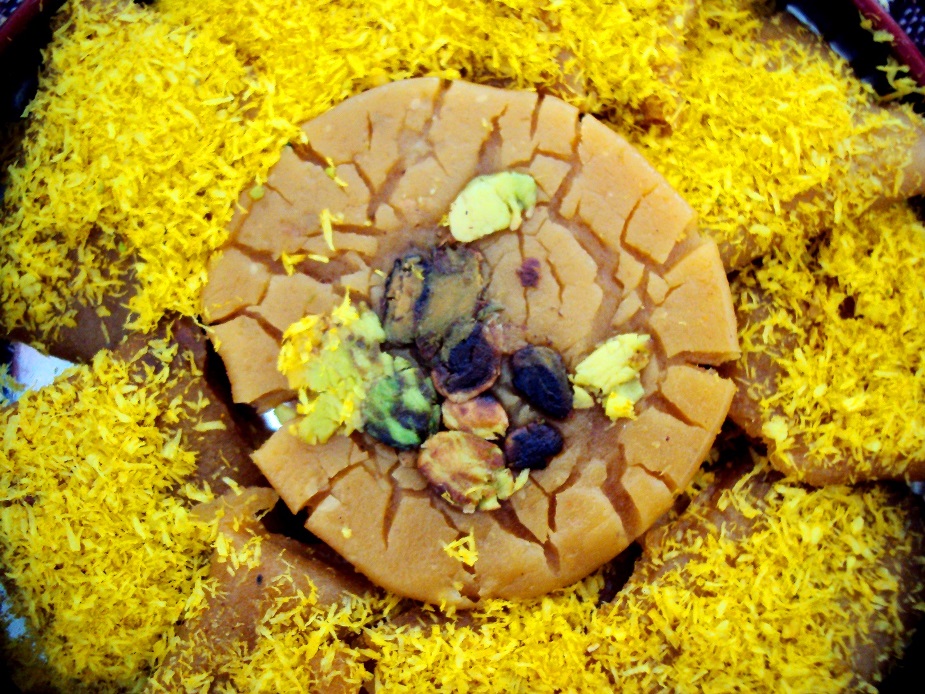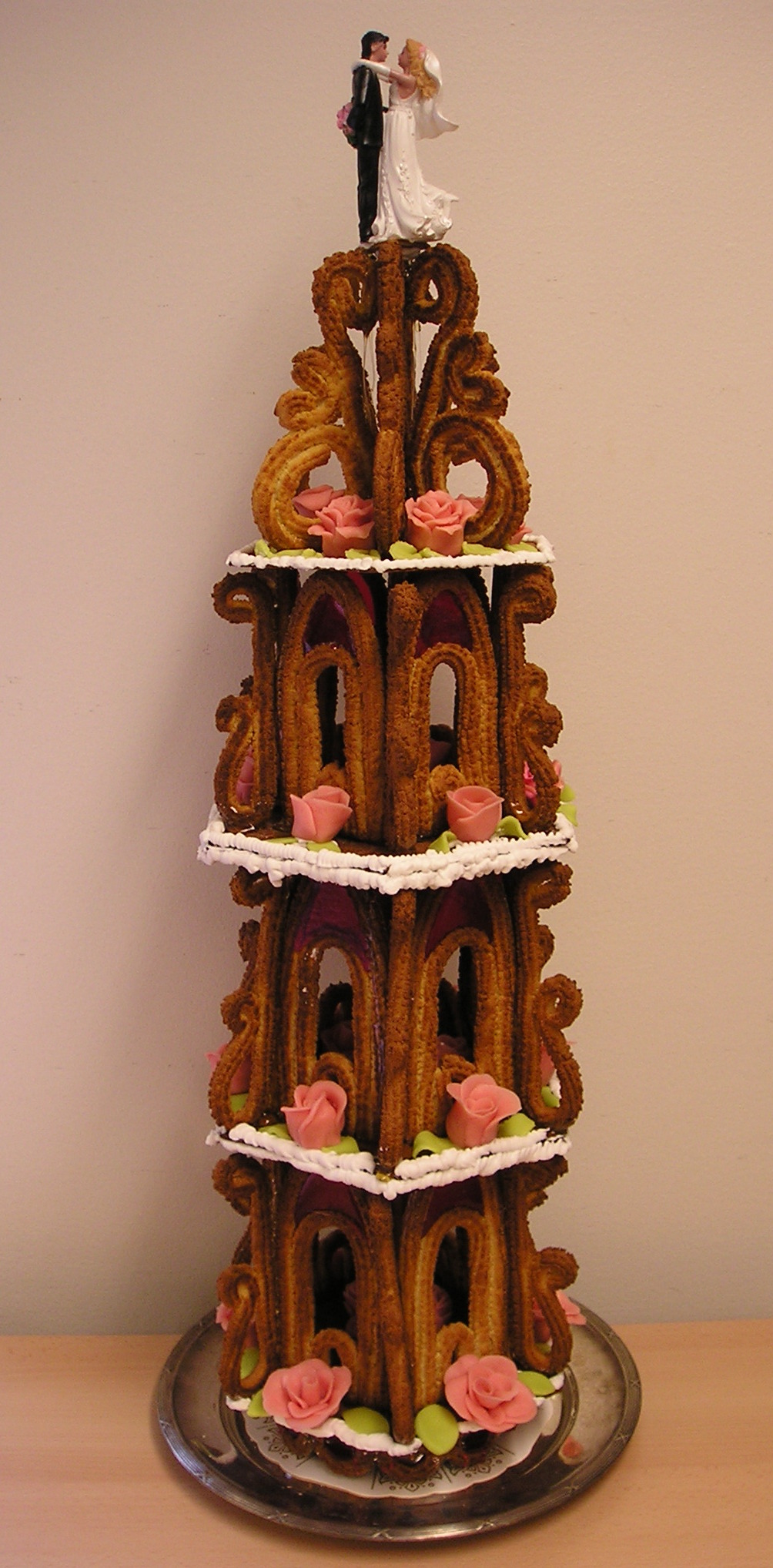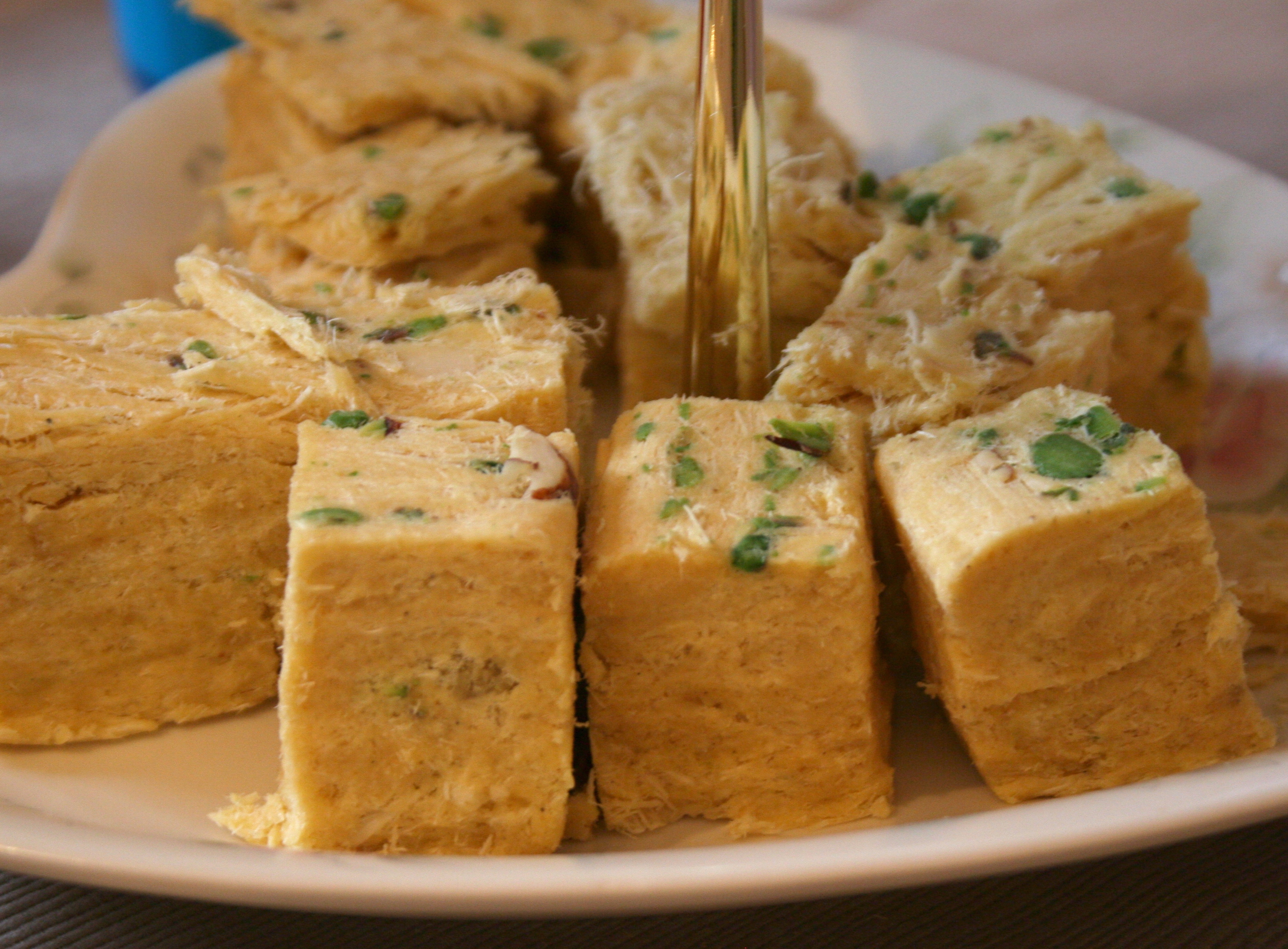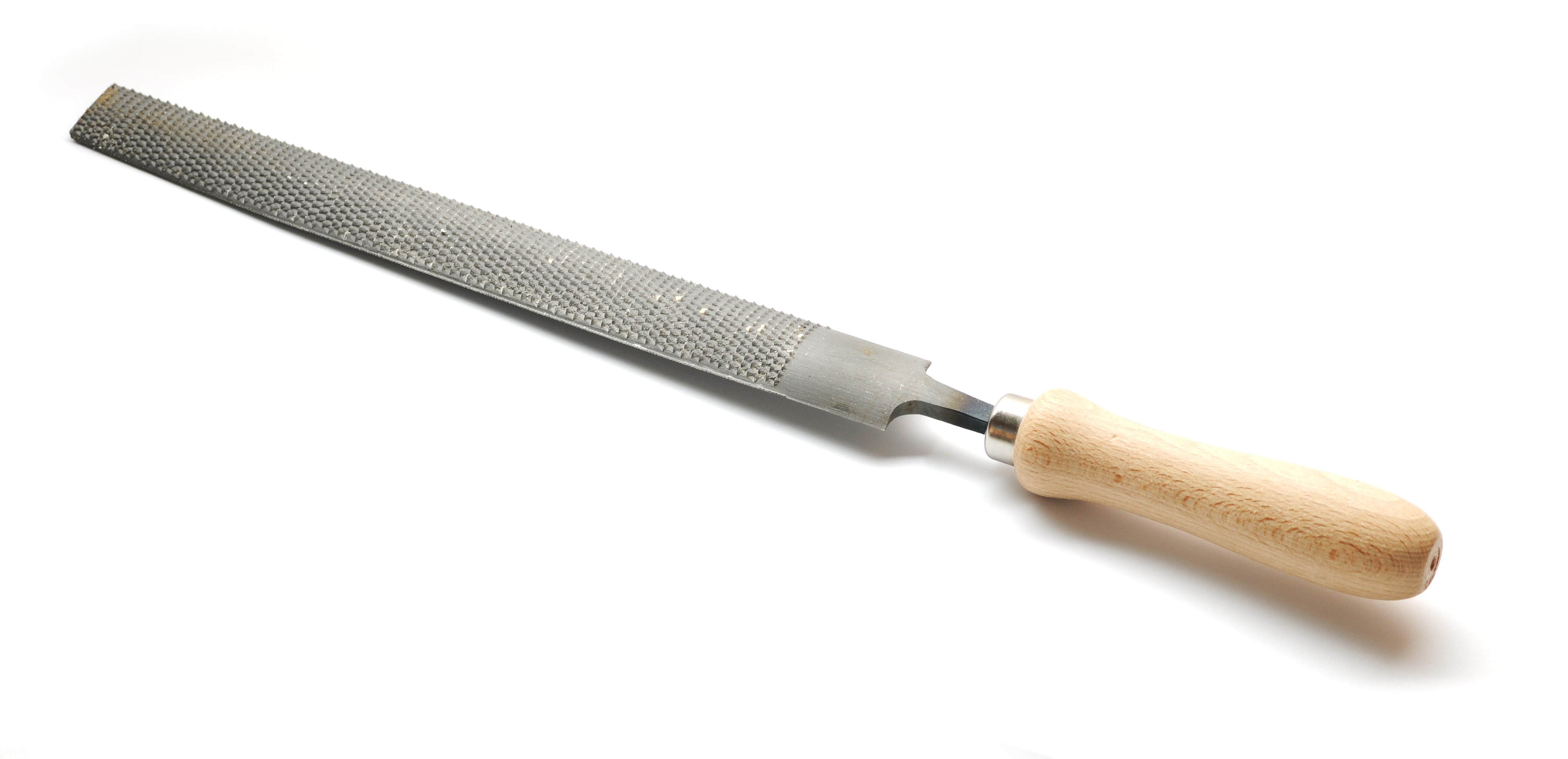|
Sohan (confectionery)
Sohan ( fa, سوهان, sohān) is a traditional Persian saffron brittle toffee made in Iran. Its ingredients consist of wheat sprout, flour, egg yolks, rose water, sugar, butter or vegetable oil, saffron, cardamom, and slivers of almond and pistachio. Sohan is originated in Qom, Iran.There are different types of Sohan including Honey Sohan, Sesame Sohan, Sohan Halwa, Almond Sohan, Sohan Gazi, Sohan Loghmeh, Butter Sohan, Sohan Pashmaki (cotton candy) and Dessert Sohan. Some people believe that when Mozaffar ad-Din Shah Qajar travelled to Qom and he was entertained with Halwa Qomi, he analogized it to a rasp (Sohan is the Persian word meaning rasp or file) which digested the food he had eaten very well. See also * Sohan papdi * Shekarpareh * Sohan halwa * Sohan asali * Peanut brittle Brittle is a type of confection consisting of flat broken pieces of hard sugar candy embedded with nuts such as pecans, almonds, or peanuts, and which are usually less than 1 cm thick. ... [...More Info...] [...Related Items...] OR: [Wikipedia] [Google] [Baidu] |
Cookie
A cookie is a baked or cooked snack or dessert that is typically small, flat and sweet. It usually contains flour, sugar, egg, and some type of oil, fat, or butter. It may include other ingredients such as raisins, oats, chocolate chips, nuts, etc. Most English-speaking countries call crunchy cookies biscuits, except for the United States and Canada, where biscuit refers to a type of quick bread. Chewier biscuits are sometimes called ''cookies'' even in the United Kingdom. Some cookies may also be named by their shape, such as date squares or bars. Biscuit or cookie variants include sandwich biscuits, such as custard creams, Jammie Dodgers, Bourbons and Oreos, with marshmallow or jam filling and sometimes dipped in chocolate or another sweet coating. Cookies are often served with beverages such as milk, coffee or tea and sometimes "dunked", an approach which releases more flavour from confections by dissolving the sugars, while also softening their texture. F ... [...More Info...] [...Related Items...] OR: [Wikipedia] [Google] [Baidu] |
Iran
Iran, officially the Islamic Republic of Iran, and also called Persia, is a country located in Western Asia. It is bordered by Iraq and Turkey to the west, by Azerbaijan and Armenia to the northwest, by the Caspian Sea and Turkmenistan to the north, by Afghanistan and Pakistan to the east, and by the Gulf of Oman and the Persian Gulf to the south. It covers an area of , making it the 17th-largest country. Iran has a population of 86 million, making it the 17th-most populous country in the world, and the second-largest in the Middle East. Its largest cities, in descending order, are the capital Tehran, Mashhad, Isfahan, Karaj, Shiraz, and Tabriz. The country is home to one of the world's oldest civilizations, beginning with the formation of the Elamite kingdoms in the fourth millennium BC. It was first unified by the Medes, an ancient Iranian people, in the seventh century BC, and reached its territorial height in the sixth century BC, when Cyrus the Gr ... [...More Info...] [...Related Items...] OR: [Wikipedia] [Google] [Baidu] |
Cookies
A cookie is a baked or cooked snack or dessert that is typically small, flat and sweet. It usually contains flour, sugar, egg, and some type of oil, fat, or butter. It may include other ingredients such as raisins, oats, chocolate chips, nuts, etc. Most English-speaking countries call crunchy cookies biscuits, except for the United States and Canada, where biscuit refers to a type of quick bread. Chewier biscuits are sometimes called ''cookies'' even in the United Kingdom. Some cookies may also be named by their shape, such as date squares or bars. Biscuit or cookie variants include sandwich biscuits, such as custard creams, Jammie Dodgers, Bourbons and Oreos, with marshmallow or jam filling and sometimes dipped in chocolate or another sweet coating. Cookies are often served with beverages such as milk, coffee or tea and sometimes "dunked", an approach which releases more flavour from confections by dissolving the sugars, while also softening their texture. Factory- ... [...More Info...] [...Related Items...] OR: [Wikipedia] [Google] [Baidu] |
Iranian Desserts
Iranian cuisine () refers to the culinary practices of Iran. Due to the historically common usage of the term "Persia" to refer to Iran in the Western world,Yarshater, EhsaPersia or Iran, Persian or Farsi, ''Iranian Studies'', vol. XXII no. 1 (1989) it is alternatively known as Persian cuisine, despite Persians being only one of a multitude of Iranian ethnic groups who have contributed to Iran's culinary traditions. The cuisine of Iran has made extensive contact throughout its history with the cuisines of its neighbouring regions, including Caucasian cuisine, Central Asian cuisine, Greek cuisine, Levantine cuisine, Mesopotamian cuisine, Russian cuisine and Turkish cuisine. Aspects of Iranian cuisine have also been significantly adopted by Indian cuisine and Pakistani cuisine through various historical Persianate sultanates that flourished during Muslim rule on the Indian subcontinent, with the most notable and impactful of these polities being the Mughal Empire. Typic ... [...More Info...] [...Related Items...] OR: [Wikipedia] [Google] [Baidu] |
Confectionery
Confectionery is the art of making confections, which are food items that are rich in sugar and carbohydrates. Exact definitions are difficult. In general, however, confectionery is divided into two broad and somewhat overlapping categories: bakers' confections and sugar confections. The occupation of confectioner encompasses the categories of cooking performed by both the French '' patissier'' (pastry chef) and the ''confiseur'' (sugar worker). Bakers' confectionery, also called flour confections, includes principally sweet pastries, cakes, and similar baked goods. Baker's confectionery excludes everyday breads, and thus is a subset of products produced by a baker. Sugar confectionery includes candies (also called ''sweets'', short for ''sweetmeats'', in many English-speaking countries), candied nuts, chocolates, chewing gum, bubble gum, pastillage, and other confections that are made primarily of sugar. In some cases, chocolate confections (confections made of chocola ... [...More Info...] [...Related Items...] OR: [Wikipedia] [Google] [Baidu] |
Florentine Biscuit
A Florentine biscuit (or simply, a Florentine) is a sweet pastry of nuts and fruit. Florentines are made of nuts (typically hazelnuts and almonds) and candied cherries mixed with sugar melted together with butter and honey, cooked in an oven. They are often coated on the bottom with chocolate, which is traditionally scored in a wave pattern with the tines of a fork for decoration. Other types of candied fruit are used as well. They typically contain neither flour nor eggs. See also *List of cookies This is a list of notable cookies (American English), also called biscuits (British English). Cookies are typically made with flour, egg, sugar, and some type of shortening such as butter or cooking oil, and baked into a small, flat shape. Cooki ... References Biscuits Nut confections French confectionery {{confection-stub ... [...More Info...] [...Related Items...] OR: [Wikipedia] [Google] [Baidu] |
Peanut Brittle
Brittle is a type of confection consisting of flat broken pieces of hard sugar candy embedded with nuts such as pecans, almonds, or peanuts, and which are usually less than 1 cm thick. Types It has many variations around the world, such as '' pasteli'' in Greece; sohan in Iran; ''croquant'' in France; '' alegría'' or ''palanqueta'' in Mexico; '' panocha mani'', ''panutsa mani'', or ''samani'' in the Philippines (which can also be made with pili nut); ''gozinaki'' in Georgia; ''gachak'' in Indian Punjab, chikki in other parts of India; ''kotkoti'' in Bangladesh; '' sohan halwa'' in Pakistan; ''huasheng tang'' (花生糖) in China; ''thua tat'' (ถั่วตัด) in Thailand; and ''kẹo lạc, kẹo hạt điều'' in Vietnam. In parts of the Middle East, brittle is made with pistachios, while many Asian countries use sesame seeds and peanuts. Peanut brittle is the most popular brittle recipe in the United States. The term "brittle" in the context of t ... [...More Info...] [...Related Items...] OR: [Wikipedia] [Google] [Baidu] |
Sohan Asali
Sohan asali ( fa, سوهان عسلی, sohān-e asali; from ''asal'' "honey") is a kind of Iranian confectionery (''sohan'') originating in Esfahan, Iran. It is made of honey, sugar, saffron, almond, pistachios and other nuts Nut often refers to: * Nut (fruit), fruit composed of a hard shell and a seed, or a collective noun for dry and edible fruits or seeds * Nut (hardware), fastener used with a bolt Nut or Nuts may also refer to: Arts, entertainment, and media Com ... and cooking oil. It’s akin to a hard toffee, being brittle and breaking into shards. It varies from the more ubiquitous Sohan from the city of Qom (sohān-e-Qomi) as it uses no wheat and much less butter and/or oil. So it’s not as short and holds its structure whilst Qom Sohan can disintegrate into powder when pressed hard. External links [...More Info...] [...Related Items...] OR: [Wikipedia] [Google] [Baidu] |
Shekarpareh
Shekarbureh (. Azeri şəkərbura) is a sweet pastry, dating back to at least the Sassanid era. Originally, it was like a halva made from sugar and almonds. Its alternate names in Persian include ''Shekarborak'', ''Shekarbora'', ''Shekarpareh'' and ''Shekarpirah''. In its different variations, the dessert is also common in Azerbaijan, Iran, and Turkey. Versions In Anatolia this pastry is called Şekerpare in Turkish and is one of the popular desserts in the Turkish cuisine. Mainly prepared by baking some soft balls of almond based pastry dipped in thick lemon-flavored sugar syrup, şekerpare is pronounced “''sheh-kehr-PAH-rih''” in Turkish. In the Republic of Azerbaijan it is called ''şəkərbura'' and is used as a dessert. It is a sweet pastry in half-moon shape, filled with ground almonds, hazelnuts, or walnuts, and sugar. Shekerbura, '' shorgoghal'', and '' pakhlava'' are the iconic foods of Novruz holiday in Azerbaijan. In Azerbaijan, it usually involves team ... [...More Info...] [...Related Items...] OR: [Wikipedia] [Google] [Baidu] |
Sohan Papdi , a similar Iranian dessert
Soan papdi (also known as san papri, shompapri,sohan papdi, shonpapdi or patisa) is a popular dessert in the Indian subcontinent. The term ''sohan'' is of Persian origin. It bears some resemblance to the Persian ''sohan pashmaki'', which gave rise to the Turkish ''pişmaniye''. It is usually cube-shaped or served as flakes, and has a crisp and flaky texture. Traditionally sold loose in rolled paper cones, modern industrial production has led it to being sold in the form of tightly formed cubes. Ingredients Its main ingredients are sugar, gram flour, flour, ghee, almond, milk, and cardamom. See also *Sohan (confectionery) * Sohan halwa *Pişmaniye, a similar Turkish dessert *Pashmak Pashmak ( fa, پشمک) is a form of Iranian candy floss or cotton candy, made from sugar. Pashmak is served on its own or as an accompaniment to fruits, cakes, ice creams, puddings and desserts. It is widely known as Persian Cotton Candy. [...More Info...] [...Related Items...] OR: [Wikipedia] [Google] [Baidu] |
Rasp
A rasp is a coarse form of file used for coarsely shaping wood or other material. Typically a hand tool, it consists of a generally tapered rectangular, round, or half-round sectioned bar of case hardened steel with distinct, individually cut teeth. A narrow, pointed tang is common at one end, to which a handle may be fitted. Use Rasps come in a variety of shapes—rectangular, round, and half-round—and vary in coarseness from finest, "cabinet", to most aggressive, "wood". Farriers, for example, commonly use rasps to remove excess wall from a horse's hoof. They are also used in woodworking for rapidly removing material and are easier to control than a drawknife. The rough surfaces they leave may be smoothed with finer tools, such as single- or double-cut files. Rasps are used in shaping alabaster. Saws and chisel A chisel is a tool with a characteristically shaped cutting edge (such that wood chisels have lent part of their name to a particular grind) of blade on ... [...More Info...] [...Related Items...] OR: [Wikipedia] [Google] [Baidu] |


.jpg)



